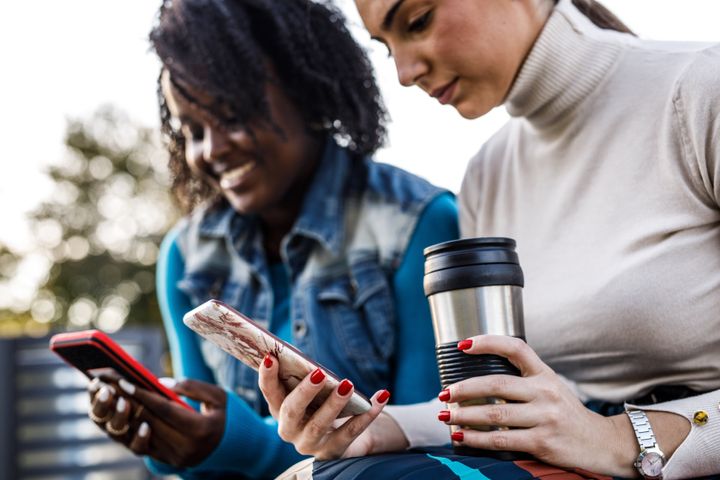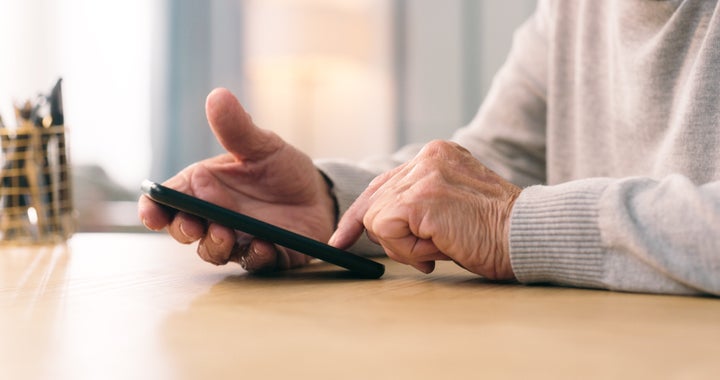
Raise your hand if you’ve ever uttered the phrase “I want to spend less time on my phone” or created a New Year’s resolution around the goal ― and then failed to do so.
If you find that it’s challenging (like, really, really challenging) to decrease your phone use, know that it’s not because you have poor willpower. “It’s hard to change your habits around your phone use because our phones are deliberately designed to hack our brains and make it difficult to turn away,” Catherine Price, the author of “How To Break Up With Your Phone” and the Substack newsletter How to Feel Alive, told HuffPost via email.
What’s more, research shows that our incoming texts and social media notifications prompt a dopamine hit, which is when the feel-good sensors in our brains fire up. Beyond all of that, cell phone addiction is another reality for some people that can lead to outcomes such as stress, anxiety and depression.
Suffice it to say: Spending less time on your phone is not as easy as just putting your down phone or turning it off. Jenny Wise Black, a licensed marriage and family therapist and the host of “Lose the Phone” podcast, said you should give yourself props for actually wanting to be on your phone less.
“It is actually very, very encouraging to me that people would even have that resolution because it implies that there is some sort of belief that things could be better,” Black said. If you find yourself getting down about your screen time, focus on the fact that you’re aware enough and feel empowered enough to make a change. “That is not the case with everybody,” said Black.
Beyond that realization, there are a number of definitive ways to decrease your phone use. Here’s how to do it:
1. Think about your “why.”
If you’re one of the many people who made a New Year’s resolution that has to do with less screen time but find yourself faltering, don’t be discouraged.
“Keep in mind that willpower alone is a horrible way to change a habit,” Price said. Instead, she recommends that you figure out a positive goal to focus on.
“In other words, instead of trying to restrict your phone use because you feel you ‘should,’ ask yourself what you want to be spending your time and attention on,” Price said.
You can also look at this as your “why,” explained Jami Dumler, a licensed clinical social worker and regional clinic director with Thriveworks based in Pennsylvania. “Often when we’re talking about being on our phone less, that’s not ultimately what it’s really about, there’s usually some other driver to that factor.” Maybe you want to be on your phone less because you want to be a more present parent or get a promotion at work.
Next, identify how your phone is interfering with your priorities and determine what you can do to make it easier to focus on those things, Price added. So, if your priority is reading new books but you find yourself scrolling social media instead, get your phone out of your bedroom and leave a book on your bedside table instead, she suggested.
“One fun way to identify your goals and brainstorm ideas is to actually write your phone a breakup letter,” Price said. “The goal is to transform your phone from a temptation you’re trying to resist to an obstacle that’s getting in the way of how you want to live your life ... With this positive framework in mind, it’ll be a lot easier to change your habits,”
2. Turn on your phone’s grayscale setting.
One science-backed way to make your phone less interesting is by turning on the grayscale feature; this is an option most smartphones have that turns the colors on your phone into hues of gray.
On iPhones, you can turn on grayscale by going to Settings > Accessibility > Display & Text Size > Color Filters. Here is where you’ll toggle color filters on and select grayscale from the options. On Android, go to Settings > Accessibility > Color and Motion > Color Correction and select grayscale from the options.
“We know that the bright colors and movement on a screen hit our dopamine receptors similar to other addictive qualities like drugs, alcohol, things like that, and so when there’s less bright colors, we don’t have as much of a dopamine high happening,” Dumler said. “So then it’s less addictive, and we’re less likely to get lost in the scrolling.”
In fact, a 2022 study found that those who turned on their grayscale setting were less tempted to pick up their phone when compared to those who did not use this tool, Dumler added.
Similarly, when your phone has the grayscale setting toggled on, “you start seeing color in your real life and you start seeing everything in your phone [as] black and white — it puts something mentally in different places in your brain,” Black noted. This is kind of like when watching a black-and-white movie, your brain categorizes that movie as old.
3. Put your phone on silent.
The sound of incoming texts and emails is hard to ignore. If anything, they actually make your brain want to pick up your phone.
“We know from science and research being done that the sound of a notification when your phone is on loud hits your brain and our dopamine receptors the same way a drug or substance would. It’s that addicting,” Dumler said. “So, if you have your phone on loud and you have notifications going, the minute you see that screen light up or you hear that little ding, we get addicted to that and we need to immediately stop what we’re doing and check it.”
It can be immensely helpful to put your phone on silent and even turn off push notifications to avoid this.

4. Put a barrier between you and your phone.
Emma Mahony, a therapist at A Better Life Therapy in Philadelphia and a mental health content creator on TikTok, previously told HuffPost that she puts a hair tie around her phone to curb her phone use.
It’s hard to scroll social media, text or browse the internet when there is an actual hair band or rubber band around your phone — “it kind of creates that mindfulness,” Mahony said.
Many folks mindlessly pick up their phones, almost as a reflex when they’re waiting in line at the store or during a commercial break. This tip brings a sense of awareness to our phone use and reminds our brains that we are going on our phones during this moment, Mahony said.
5. Move your phone away from your body.
When something is constantly within your view, it’s only natural to want to reach for it. To fight this, Black said it’s important to get your phone away from your body and out of your visual line. That means out of your hand, out of your pockets or off of the table in front of you.
You can try leaving your phone upstairs or putting it in the kitchen drawer while you watch a movie with your family. This isn’t easy, so if it takes a few tries, that is OK.
What we experience with our phones now, “it’s actually separation anxiety. So if you’re having separation anxiety ― if you’re an adult, even if you’re a kid ― around any particular relationship in your life, that’s something that we used to work on in therapy,” Black said. “None of us think anything about the levels of separation anxiety we have from our phones.”
6. Organize your apps intentionally.
If you’re always opening your TikTok app or your Pinterest app, it could be a good idea to make those things a little less accessible to ease the temptation.
You can keep an app active while adding a few extra steps — or in this case, clicks — to use it, Dumler advised. This could mean putting it in a folder or on one of the subsequent screens that follows the main home screen.
To do this, Dumler suggests that you move your frequently used apps off of your home screen. How to go about this depends on your phone, but it’s another easy Google search to figure out how (if you don’t know already).
This way, it isn’t immediately accessible and you won’t be so inclined to open the app.
7. Or consider removing your social media apps entirely.
You probably spend hours and hours mindlessly scrolling the latest updates on Instagram. One natural way to spend way less time on your phone? Remove your social media apps.
“Take all social media off of your phone, anything that you could kill time with, take off your phone,” Black said.
If you still need to use social media for work, to stay in touch with others or even just enjoy checking it, you can still use it, but Black suggested only using social media on your computer if you go this route.
“For reason we do not really understand, when someone is on their laptop or computer looking at social media it does not have the same impact on their [mental health],” Black said.
Black added that social media impacts everyone differently, but it is known to cause anxiety, can get folks stuck in a negative comparison cycle based on what they see online and can lead to depression.
8. If you are really committed, consider getting a second “dumb phone.”
“I get a lot of pushback on this, but I am not going to stop because I truly feel like it’s the hope of our society, I think everyone needs to start experimenting with a second phone,” Black said.
In other words, buy yourself a cheap, non-smartphone to take out with you instead of your smartphone. This will teach you how to be reliant on a phone that doesn’t have all of the features that come on a standard smartphone while still giving you the necessary qualities — like calling or texting — you need, Black explained. You can try this out for just an hour a day to start and move up from there.
You certainly can give up your smartphone altogether, but you don’t have to.
“I think it’s important to highlight, too, that phones aren’t all bad. They are convenient, they can be a great resource to look things up easily, or have that calculator handy at the store when you’re shopping and a great way to connect with people,” Dumler said.
But it’s important to remember that balance is everything here. If you find that you can’t leave your phone in the other room without feeling uncomfortable or that you’re constantly ignoring your partner because of incoming notifications, it may be a sign that something’s out of whack.
“If you’re getting out of balance, and your phone is taking over a lot of other areas, [being on your phone less] may be a great goal for you,” Dumler said.